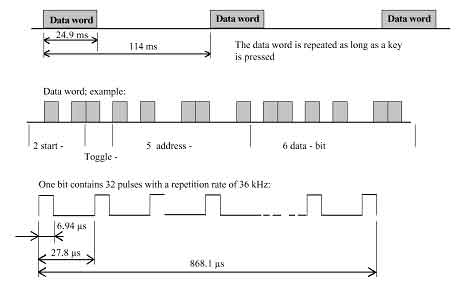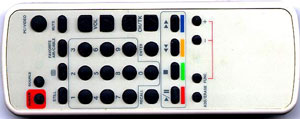It's the additional information to plug-ins DCD
and sndRemote
| Modulation |
| Bi-phase coding |
A rising edge within a time window is equivalent to a "1",
a falling edge represents a "0":

|
| Pulse-distance modulation |
|

|
| Pulse-length code |
|

|
|
In most remote-control transmission systems, only small
data rates are transmitted to control the functions of home
entertainment equipment. A vital pre-requisite is the safety
of transmission where an incorrect interpretation of the
transmitted code is not permissible. Unintelligible signals
must be ignored. Usually, commands are repeated until the
remote-con-trolled device reacts as desired. The operator
can directly observe the result of pressing a key by visual
feedback.
The commands can be transmitted by variation of the coding
of the optical carrier. Some methods of modulation have
been established. Nowadays, only the digital transmission
of words is used where the word length can vary which means
one word can include a different number of bits.
The three commonly used representations of a bit in remote-control
systems are described in the following paragraphs.
Special types for different operating frequencies are available
in the range from 30 kHz to 60 kHz. Standard types are available
for the frequencies 30 kHz, 33 kHz, 36 kHz, 36,7 kHz, 38
kHz, 40 kHz and 56 kHz. Other frequencies in this range
can be realized on request.
The data words to be transmitted consist of a defined number
of bits. Word lengths and coding method are defined in the
transmission standards. Several transmission standards are
now accepted worldwide. Some of them are described in the
following paragraphs.
In European equipment, the most commonly used standards
are the RC 5 code and the RECS 80 code. Another popular
transmission language is the NEC code (Far East).
In addition, many important consumer electronic product
manufacturers have their own company standard regarding
the transmission code.

|
| Standards of codings |
| RC-5 |
|
In the RC 5 standard, a bi-phase coding is applied. The
carrier frequency is fixed at 36 kHz. Similar transmission
standards are used in the frequency range between 30 kHz
and 56 kHz.
The transmission of a word begins with two start bits, followed
by a toggle bit. The toggle bit changes its value at each
key operation. With this change, an interruption of the
transmission link can be distinguished from a multiple key
pressing. The five address bits address the device to be
controlled. The command bits contain the information to
be transmitted.
Each bit in a data word consists of a burst of 32 pulses
with a repetition rate of 36 kHz. The equivalent times are
shown in the pulse diagrams.

Used by PHILIPS and SAMSUNG.
|
| NEC |
The NEC code starts the transmission using a so-called
leader code, a burst of a length of 9 ms, followed by the
data word after a pause of 4.5 ms. This leader code is responsible
for leveling the internal control loops in the receiver
modules.

As long as a key is pressed, only the leader code is repeatedly
transmitted, followed by a single bit. A specialty of this
code is the property of constant word length in connection
with a pulse-distance modulation. Both address and command
bit are transmitted twice, first as the normal byte followed
by the inverted byte. This is shown in figure 9. The burst
defining a bit contains 22 pulses each of a length of 8.77
µs with a period of 26.3 µs. A "0" is
represented by a pulse distance of 1.125 ms, the "1"
with 2.25 ms, respectively. 8 address bits are used to identify
the device to be con-trolled. A further 8 bits are used for
the transmission of the command. As mentioned above, the words
are always followed, without a pause, by the inverted words,
e.g., the transmission of the address "00110111"
and the command "00011010" is performed by sending
the word: "00110111'11001000'00011010'11100101".

Used by HITACHI, NOKIA, AIWA, AKAI, AverMedia.
Creative RM-900 (SoundBlaster Live Platinum) sends data word
twice. The first address byte is not equal inverse of the
second address byte (C1h and 44h). For compatibility the first
2 address bytes are not compared and used both.
|
| RECS 80 / RC-4 |
| With a length of 70 ms, the data word in the RECS 80 code
is nearly three times as long as that in the RC 5 code. The
RECS 80 code operates with a digital pulse-distance modulation.
As in the RC 5 code, toggle, address and command bits are
used. Sometimes, a flash mode is found in combination with
the RECS 80 code where single pulses of infrared radiation
are transmitted instead of bursts. A carrier frequency of
400 kHz is also used instead of the common carrier in the
range between 30 and 56 kHz.


Used by JVC.
|
| SONY / Panasonic |
|
Pulse-length modulation. Up to 20 data bits.
|
Result of decoding in a plug-ins
DCD and sndRemote is a
28-bit identifier such as 0FAAAACC. Where F - a flag determining
modulation, A - the address, C - command. For SONY the last 24
bits determine a code of command.
|
AverMedia TVPhone98 w/VCR

JVC HR-J727MS

SAMSUNG CK-6202WTR

SONY RM-SR130

SONY RM-836

CREATIVE RM-900

Pioneer CU-PD046 (CD Player Pioneer PD-203)

TV Tuner Tekram M205

|
















